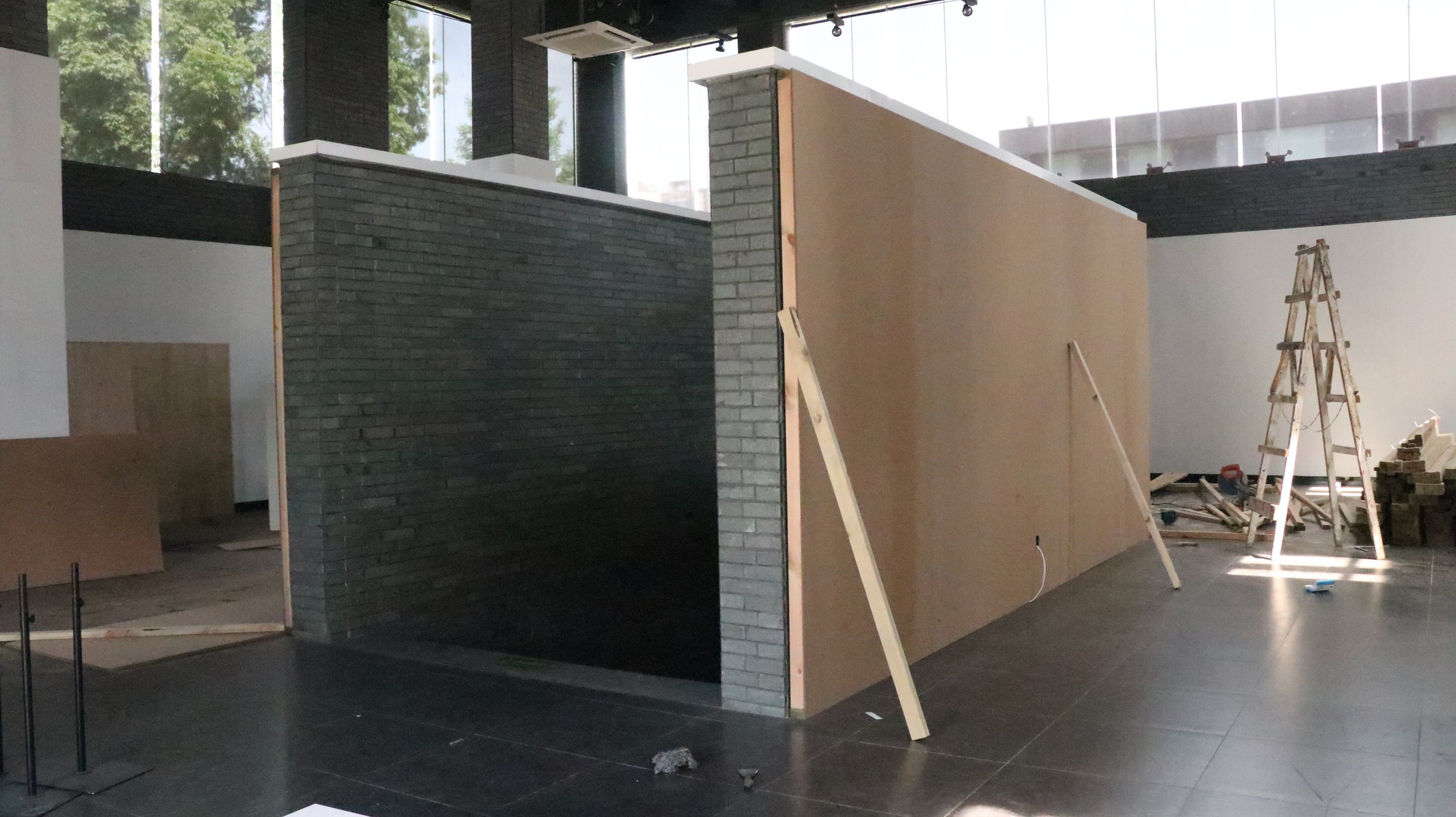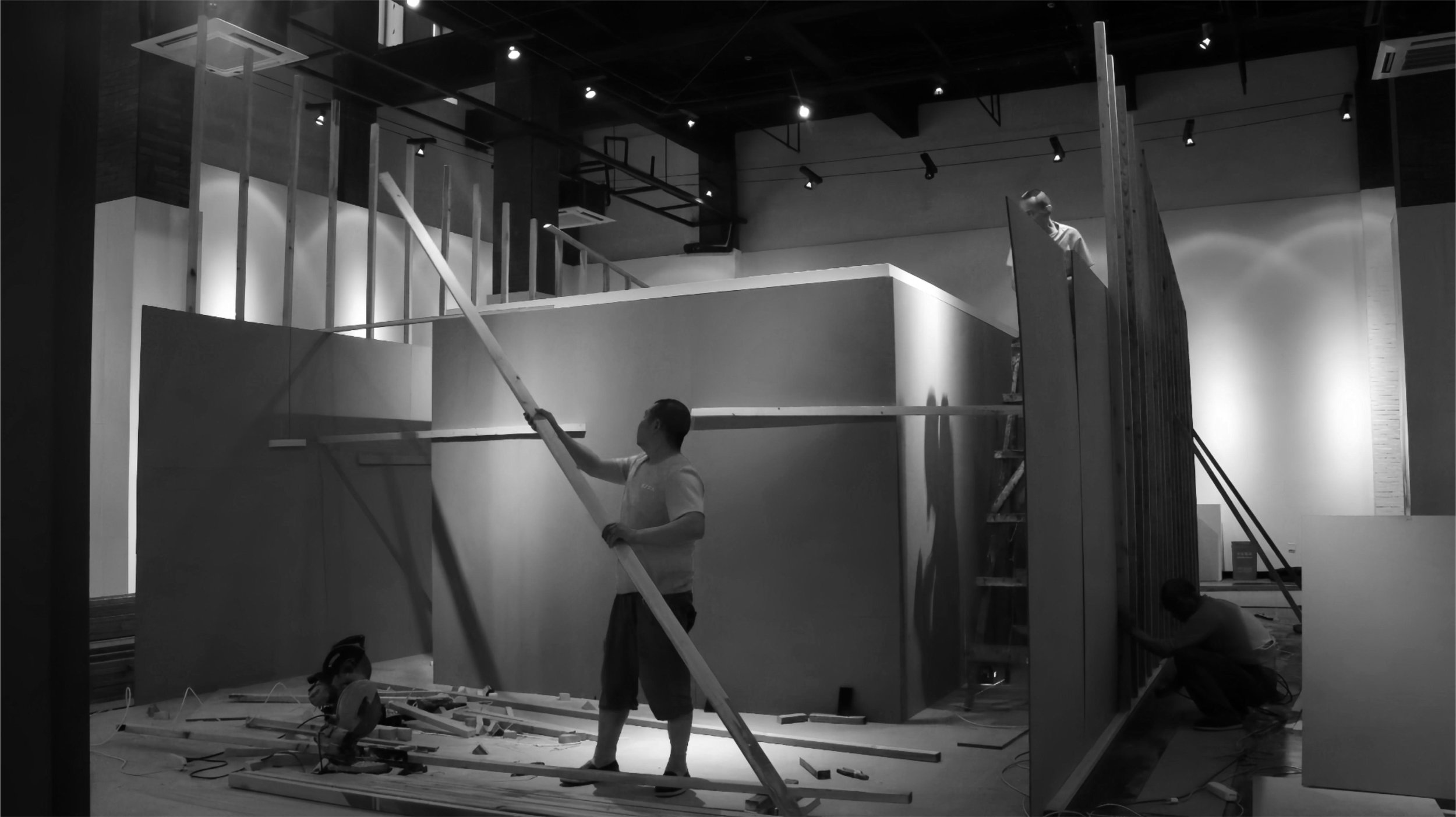
Installation/architecture that surrounds the museum. Pine, MDF, paint, sound unit, seating, lights, brick, 2024, 1100cm*600cm*500cm
‘Moment’
Work by Xinghao Liang & Mengmeng Luo
one of the Rhino sketch for “Moments”
The staircase of the art museum, which connects the exhibition hall on the first floor with the exhibition hall on the second floor, interestingly, stands directly in the center of the museum due to the special cultural background and feng shui customs at the time of the construction of the museum. Like a sculpture, it is the most inconspicuous yet the most eye-catching object.
Reference: ‘The Sensorama Simulator, a machine from 1962 that played a 3D film along with stereo sound, aromas and wind in order to create an immersive sensory environment. It was one of many 3D-related creations that visionary inventor and cinematographer Morton Heilig gave the world.’
-From Jon Turi’s writing ‘The sights and scents of the Sensorama Simulator’
Part of architectural drawings, thanks and credit to ©MY-X Studio
About
Experience is the direct encounter with pure 'reality,' unfiltered by textual interpretation or the distortions of symbolic thought. It is reality as it is, not as it is reported. The purpose of this paper is to articulate the process of artistic thinking and presentation rather than to impose additional interpretations.
In Moment, a large-scale installation by artists Luo Mengmeng and Liang Xinghao, the boundaries between architectural space and sculpture are intentionally blurred. Based on the anticipated trajectory of the viewer’s movement, the artists transform the gallery's staircase into an accessible cinematic structure—simultaneously a functional building and a monumental sculptural form within the exhibition. As visitors ascend the stairs and glance back or upwards, they experience the sensation of emerging from an enigmatic container or a towering ridge. Before them lies a blank gallery, while behind them, a sound-emitting architectural 'mouthpiece' invites them into yet another liminal space. This journey leads the audience from one 'mouthpiece' to another, transitioning from the ground floor to the second level. Upon reaching the first floor, viewers encounter two blue, 45-degree-tilted openings emitting low-frequency sounds, seemingly inviting them to make a choice—whether to enter or not.
Some audience members, responding to this auditory invitation, step into a narrow blue corridor through two separate entrances on the left and right. At both ends of the passage, low-frequency sound units embedded in the walls create a progressively intensifying pitch. The deep vibrations seem to urge forward movement, reverberating through the walls with an almost percussive force. At the far end of the corridor, a red glow emerges subtly seductive yet enigmatic presence. As the two streams of visitors converge at the passage’s end, they find themselves facing small windows of varying heights, radiating an intense red light. These openings, merely 20 cm in length, permit only glimpses inside.
Peering through these apertures, whether by crouching or bending slightly, viewers discover an uncanny interior: a red-illuminated cinema. Traditional cinema chairs are neatly arranged, yet the room lacks any visible entrance or exit. Strangely, unlike conventional cinematic experiences where the audience faces a screen, here, the chairs are turned towards the observers in the tunnel. The expected relationship between viewer and viewed is inverted—suddenly, the audience is not merely a spectator but a performer, poised as if awaiting their cue to step onto a stage. At the far end of the cinema, a small opening mimic the window before them, resembling a film projector’s aperture. This opening leads to the exterior exhibition space, suggesting another layer of interconnection. A visitor who refrains from entering the tunnel and instead explores the building’s exterior might stumble upon a hidden opening at the back, offering a clandestine view into the cinema. There, they would encounter not just the cinematic interior but also the gaze of those peering from the opposite side—a recursive interplay of seeing and being seen.
In this work, the cinema is rendered an inaccessible space, positioning the viewer behind the screen, confronting the unknown. Narrow corridors, dim lighting, and unsettling sounds transform the viewing experience into a performative and spatial event. Through meticulous artistic intervention, wood paneling is reimagined as vast expanses of rusted, peeling metal, merging seamlessly with the gallery’s staircase. The installation’s scale varies dramatically, from an entrance as low as 2.2 meters to a peak height of 5 meters, creating an immersive, sunken structure that extends into infinity.
At this point, silence dominates, for no human language or conceptual framework can fully encapsulate the experience. This realm is one of paradox and negational contradiction beyond resolution. As Ramana Maharshi observed, the Self, as pure Consciousness, is the ultimate observer. Everything else—self-esteem, spirit, body—exists only as its objective manifestation. Beyond the Self, no entity can claim the status of a true 'viewer.' The 'ego,' being neither objectifiable nor externally knowable, stands as the observer of all else. Yet, under the scrutiny of the Absolute, the distinctions between subject and object dissolve. The self-cease to be either observed or observed, existing beyond duality.
“Man stands in his own shadow but wonders how it is dark around him.”
Our aim is to allow viewers to encounter their own objective reality in a certain 'absolute' space. We focus on the intersection of filmic montage and live spatial experience. The significance of these film installations extends beyond their operability or materiality; they enable cinematic elements to carry narrative and metaphorical weight, constructing their own spatial montage—a medium that unfolds through the viewer’s movement.
Since the late 20th century, following the Cold War and the rise of globalization, artists have explored themes of race, gender, and class while reconsidering the intersections of nature, art, technology, and modern life. However, as Richard Wagner lamented, in the age of reason and science, humanity has lost its reverence for nature, and the once-integrated relationship between artistic forms has fractured into isolated disciplines, striking art of its original vitality. Our work extends Wagner’s concept of Gesamtkunstwerk (the total work of art) and draws inspiration from Ilya and Emilia Kabakov’s use of spatial narratives, aiming to dissolve boundaries between visual art, music, performance, and architecture. The goal is not merely to present art but to generate an all-encompassing, 'non-art' experience that envelops the sensory system, making viewers forget they are inside a work of art.
At the same time, Gregor Schneider and Rachel Whiteread’s explorations of 'room' and 'negative space' inform our reflections on contemporary art spaces. Within the context of museums and white-cube galleries, we question whether the site itself becomes part of the artistic experience. Daniel Buren argued that the museum is an ideological construct, manifesting in all its spaces, not just in those designated for display. Building on this premise, our work seeks to emerge 'organically,' resisting passive interpretation. Rather than directing meaning, we invite viewers into a space where their movement, perception, and choices become integral to the unfolding experience.
About
何为体验?体验是对纯粹‘现实’的直接感知,而非经由文本解读或象征性思维过程所扭曲的现实。它是未经报道的真实存在。本文旨在阐述艺术家的思考与呈现过程,而非赋予其额外的诠释。
在艺术家罗萌萌与梁星昊的大型装置作品瞬间中,建筑空间与雕塑的界限被有意模糊。基于观者即将行进的路径,艺术家们将画廊的楼梯改造为一座可进入的影院建筑,它既是一个功能性建筑,同时又作为展览中的巨型雕塑存在。当观者拾级而上,回望或仰视时,会产生仿佛从某个未知容器或高耸山脊中步出的感觉。眼前是一片空白的画廊,而身后则是一个发声的建筑‘喉口’,引导他们进入另一个中介空间。这一旅程使观众从一个‘喉口’步入另一个‘喉口’,从一层走向二层。当观者抵达一楼时,会看到左右两侧各有一个倾斜45度的蓝色开口,低频声从中传出,似乎在邀请他们做出选择——是否进入。
这是一次实验,从2024年5月到7月,部分观众回应了这一声音的邀请,从左右两个不同入口进入狭窄的蓝色通道。通道两端墙内嵌有低频音响单元,随着深入,音调逐渐升高。强烈的震动仿佛催促着他们前进,如同敲击墙壁的回响。在通道尽头,隐约浮现出一抹红光,既神秘又带有某种诱惑性。当两侧的观众在通道尽头相遇,他们会驻足于拐角处,面对几个高低不一的小窗。这些仅有20厘米长的小窗散发出强烈的红色光芒,仅允许窥视其中一角。
如果观者俯身或稍微弯腰向窗内望去,会发现整个内部空间竟是一座被红光笼罩的电影院——整个空间被赤色光辉填满,传统影院座椅整齐排列,但奇怪的是,房间内既无入口,也无出口。更不寻常的是,与常规观影体验不同,这里的所有座椅都朝向隧道中的观察者。观看与被观看的关系瞬间颠倒——观众不再是被动的旁观者,而是如同即将登台的演员。远处的墙面上,有一个微小的开口,与眼前的窥视窗极为相似,仿佛是电影幕布后方的放映窗口,而它却通向建筑外的展览空间。如果此刻有观众未选择进入通道,而是从外部欣赏这座建筑锈蚀的外观,他们或许会在建筑背角无意间发现一个隐蔽的开口,窥探到影院内部,并与另一侧正透过窗口凝视的观众四目相对。
在这个作品中,影院被塑造为一个无法进入的空间,观众被置于屏幕后方,凝视着未知。狭窄的通道、昏暗的光线与令人不适的声音,使观看体验本身成为戏剧性的内容。通过精心绘制与处理,木质面板被转化为大片锈蚀剥落的金属,与画廊的楼梯相连。通道入口最低处约2.2米,而建筑最高处则达5米,整体呈现出一种沉降式的结构,引导观者通向未知的维度。
此刻,沉默占据主导地位,因为任何人类语言或概念框架皆无法完全表达这种体验。这是一片由否定与矛盾占据的领域,一个无法调和的悖论,如拉玛那·马哈希所言,‘自我’作为纯粹意识,是终极的观察者。除‘自我’外,一切——自尊、精神、身体——皆为其客观对象。因此,除了‘自我’或纯粹意识本身,任何存在皆无法称为真正的‘观看者’。由于‘自我’无法被客观化,亦无法被他物认知,而‘自我’又是万物的观察者,主观与客观的关系只能存在于相对层面;在绝对层面下,此二者皆消解。在绝对观察之下,它既非观察者,亦非被观察者,不属于主观或客观的范畴。
“人站在自己的影子里,却困惑于四周为何一片黑暗。”
我们关注电影蒙太奇叙事与现实环境的结合,目标是让观者在某种‘绝对’的空间中体验自身的客观现实,这些电影装置的意义不仅在于其可操作性或物质属性,更在于它使电影的构成元素承载叙事与隐喻表达,从而通过‘空间蒙太奇’建立自身的叙事。
自20世纪晚期冷战结束及全球化浪潮兴起以来,艺术家们开始探索种族、性别与阶级议题,并重新思考自然、艺术、科技与现代生活之间的关系。然而,正如理查德·瓦格纳所言,在理性与科学时代,人类逐渐失去了对自然的敬畏,艺术形式之间原本和谐的联系被割裂,各自朝独立方向发展,最终导致艺术失去了其原始的感召力。因此,我们借鉴瓦格纳的‘整体艺术’(Gesamtkunstwerk)理念,并受到伊利亚与埃米利亚·卡巴科夫(Ilya and Emilia Kabakov)运用空间元素构建叙事的影响,希望淡化视觉艺术、音乐、表演与建筑之间的界限,形成一种全面的感知方式。这种‘非艺术’体验将超越单一媒介,使观者忘却自身正置身于一件艺术作品之中。
与此同时,格雷戈尔·施奈德(Gregor Schneider)与蕾切尔·怀特里德(Rachel Whiteread)关于‘房间’与‘负空间’的探索,也促使我们思考当代艺术的观看方式。在博物馆与白盒子画廊的观看语境下,我们不得不思考观者通过作品所追寻的‘场所感’,即——观者所处的位置本身是否即为艺术。从丹尼尔·布伦(Daniel Buren)的视角来看,博物馆是一个整体,其意识形态贯穿于所有空间,而不仅限于展览区域。在此基础上,我们希望作品能够‘有机’地生成,而非被动地接受观者的诠释。与其提供明确的意义,我们更愿意邀请观众进入一个空间,在其中,他们的行进、感知与选择,皆成为作品不可或缺的一部分。
Rhino sketchs for “Moments”
Installing in process
Title
Moment
Year
2024
Materials
Installation/architecture that surrounds the museum. Pine, MDF, paint, sound unit, seating, lights, brick
Dimensions
1100cm*600cm*500cm
Exhibitions
Southern Monsoon, XLY MoMA, Chengdu, China, 2024





















